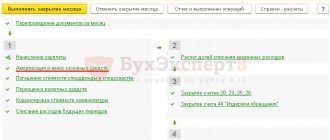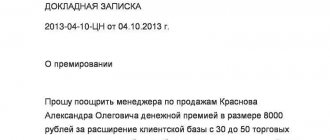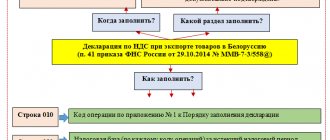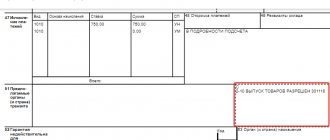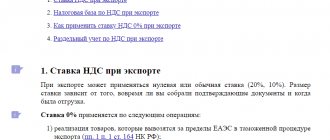Encouraging customers is a technique without which it is almost impossible to imagine running a business. It is needed to attract additional customers and increase loyalty. A bonus for achieving established purchase volumes is one of the forms of such incentives.
Question: How to reflect in the accounting of the supplier organization the costs associated with the provision of a bonus (premium) at the end of the quarter to a buyer who fulfills the terms of the supply agreement on the purchased volume of non-food products, if, according to the terms of the supply agreement, the cost of previously supplied products does not change? As a bonus provided for in the additional agreement to the supply contract, the organization transferred 20 units of products to the buyer. View answer
What is a purchasing bonus?
The Tax Code of the Russian Federation does not differentiate between incentive options such as discounts and bonuses. To determine them, one should refer to business practice. Discounts and bonuses are, as a rule, a reduction in the cost of products under a purchase agreement.
The premium does not imply a reduction in the cost of the goods. This is the payment of remuneration to the buyer upon reaching a certain volume of purchases. That is, the price of the product remains the same, but the buyer receives money from the seller.
Question: The supply contract was concluded in 2011 with the condition of annual extension for the next year. There are no provisions in the contract regarding the provision of a premium to the buyer. In 2021, the parties, by an additional agreement, agreed to provide a bonus without changing the price of goods for the volume of purchases for certain periods, including for the fourth quarter of 2021. Is it possible to issue a bonus for completing the volume of purchases after almost three years? Is this premium subject to VAT? Can the seller include this premium in expenses? View answer
When is the bonus paid? The contract establishes a certain volume of purchases. If the buyer reaches a certain target, he receives a reward from the seller.
Let's look at an example. A wholesale company entered into an agreement with a counterparty for the purchase of ballpoint pens. It states that a bonus is paid on the purchase of every thousandth pen.
Question: The organization plans to pay customers a bonus for completing the volume of purchases of non-food products as a percentage of sales volume. How to determine the basis for calculating the premium (sales volume) - with or without VAT? View answer
Selections from magazines for an accountant
Source: Glavbukh magazine
To maintain stable and long-term relationships with customers, suppliers use different reward systems. Companies often agree in advance that the seller will pay a bonus for fulfilling certain conditions. This could be a monetary reward or, for example, free products. There is no definition of bonus as such in the legislation. Financiers believe that a premium is a sum of money paid to the buyer for fulfilling certain conditions of the contract. For example, for the volume of goods purchased (letter of the Ministry of Finance of Russia dated September 7, 2012 No. 03-07-11/364).
Moreover, the condition for such incentives can be specified both in the contract itself and in a separate agreement. After all, any additional agreement is an integral part of the contract itself (clause 2 of Article 424 of the Civil Code of the Russian Federation). But the size of the bonus can be any. It is determined by the seller and agreed upon with the buyer (clause 4 of Article 421 of the Civil Code of the Russian Federation).
Accountants often ask whether the seller can pay the premium not in money, but in goods, and is it possible to stipulate this condition in the contract? I’ll say right away that such a condition may be specified in the contract. However, incentives in the form of goods are more correctly called bonuses. This operation involves the delivery of an additional batch of goods or work to the buyer free of charge. In this case, such a bonus must be taken into account as two operations: a discount is received and goods are accepted against the seller’s receivables. In this case, the amount owed by the supplier should be considered as an advance payment. Officials from the Russian Ministry of Finance explained this point in a letter dated August 31, 2012 No. 03-07-15/118.
Features of drawing up a purchase agreement
The law does not contain clear requirements regarding the preparation of a procurement agreement. However, it makes sense to list these provisions in it:
- The amount of purchases in terms of value or quantity, upon reaching which a bonus is paid. For example, this could be either the purchase of a thousandth product or the purchase of products worth 500,000 rubles. The parties to the agreement may set different levels. For example, a bonus can be paid upon the purchase of every thousandth, two thousandth, three thousandth product.
- The period for which the specified amount of purchases must be made. For example, it could be a month, a year.
- Features of determining the size of purchases. For example, this could be a cumulative total.
- The procedure for paying remuneration (for example, this could be a transfer of money to the buyer’s account).
- The person responsible for recording the size of purchased products.
Question: How to reflect in the accounting of a purchasing organization that applies the simplified tax system, the receipt of a premium (bonus) from the supplier for achieving a certain volume of purchases of non-food goods for the month, if the premium is provided for in the supply agreement, does not change the price of previously purchased goods and, by agreement of the parties, is counted as an advance issued to the supplier for the delivery of the next batches of goods? The amount of the bonus due to the organization in accordance with the terms of the contract for the purchase of a certain quantity of goods amounted to 15,000 rubles. View answer
The buyer himself may be responsible for payments. He must provide an application report to confirm his calculations. Its form and submission deadlines are established in the purchase agreement. You can indicate in it the timing of verification of the application report by the seller.
IMPORTANT! It is advisable to record the seller’s consent using a special act.
Categories
A sales agent's salary is usually paid on a commission or bonus basis. His job responsibilities include promoting the company's products on the market and selling them. Accordingly, the sales agent's fee should directly depend on the sales volume: the higher the sales volume, the more income the company will receive and the higher the employee's salary.
When earning on a commission basis, sales representatives usually receive commissions in accordance with the results achieved on those parameters that are under their control and depend on them. The commission percentage may depend on:
- the target level of income for sales personnel determined by the manager;
- product profitability;
- difficulties in marketing specific products;
- the type of customers attracted or served by the sales representative;
- region in which the product is sold.
The commission percentage can be constant for any sales volume, or it can be sliding, increasing as sales volumes increase.
The average salary of a sales representative is calculated using the formula:
salary +% of customer payments (or fulfillment of another indicator).
Awards (bonuses) are an assessment of the sales representative’s performance according to the plan. If you fulfill the plan or achieve certain performance indicators, receive a bonus. Bonuses can be paid for professionalism and length of service. For a sales employee, the criteria for paying bonuses may be:
- customer focus;
- quality of work, absence of errors;
- exceeding delivery volume plans by a certain percentage, for example 10%;
- Attraction of new clients;
- initiative;
- work experience in the company, etc.
Enterprises, as a rule, use combined remuneration systems:
- salary + commission;
- salary + bonus (bonus);
- salary + commissions and bonus (bonus).
In combined systems, an employee's salary consists of two parts: fixed (salary, tariff rate) and variable (commission or bonus).
A fixed salary is a permanent element and depends on the amount of time the sales representative works.
The variable part depends on the results obtained from performing a certain amount of work. For sales agents, this is sales volume and invoices paid by customers.
Salary + commissions. In this case, when determining the amount of remuneration to employees, employers should remember that employee activity increases due to the amount of commissions. Therefore, as a rule, when using this remuneration system, the fixed part of the payment does not exceed 15–20 thousand rubles.
Commissions directly depend on sales volume. The more money from sales goes to the company's accounts (or the higher the actual profit), the higher the commission percentage.
For your information
It is convenient to calculate the actual profit for calculating commissions based on payment, as when applying the simplified tax system: funds from the sale received to the company’s current account, minus actual expenses incurred.
Salary + commission is a good option that allows you to control employees while encouraging their activity.
Salary + bonus (bonus). The difference compared to the previous payment method is that the fixed part exceeds the variable part of the remuneration much more than in the “salary + commission” system, for example, the salary is 2/3 of the employee’s average income.
The “salary + bonus” system is effective in certain situations, for example, if the company is interested in attracting new customers and stimulating repeat orders.
The choice of remuneration system depends on the goals set by the company. So, the goals could be the following:
1. Increase company income through sales. As a rule, commissions are applied for incentives as a percentage of profits or the amount of funds received.
2. Increase sales of specific products, for example expensive ones. In this case, it is worth paying higher commission rates on high-margin products or on any other goods that the company is particularly interested in selling.
3. Increase the company’s income through new clients. To achieve this goal, employees are usually motivated by bonuses. For example, for attracting two clients and receiving payment from them for products, goods, work, services, an employee is paid 5,000 rubles.
4. Increase sales to existing customers. Both a bonus for increasing sales to existing customers and commissions can be paid. The bonus can be linked to a quota for repeat orders, and commissions can be paid at higher rates for repeat orders.
Salary + fixed bonus. In large trading companies with a large turnover, sales representatives are paid a solid salary and a fixed bonus if the plan is fulfilled or established indicators are achieved.
The fixed bonus portion has a certain upper threshold beyond which it cannot rise. Typically this payment is about a third of the salary.
Goal of motivation: the sales representative must understand that his earnings depend on his efforts and performance, i.e. the principle “he who works more earns more” works.
Note!
The effectiveness of the motivation system, especially when it comes to sales personnel, depends on a number of factors, for example:
- from the company's sales strategy;
- sales systems, features of sales management;
- features of business processes in the company;
- distribution of responsibilities within the sales department and between departments of the company.
When choosing a motivation system, you should take into account the functional responsibilities of department employees. Thus, the motivation system of a retail company will be very different from the motivation system of a wholesale company: managers of such companies are required to have different work behavior, they have different tasks and functions, and different performance criteria.
Some motivation systems that are used in practice are presented in Table. 1.
Here are examples of a payment scale for paying bonuses to sales agents:
1. The bonus is awarded for each order paid by the buyer that exceeds 10 thousand rubles, in accordance with the payment scale presented in table. 2.
table 2
Payment scale based on orders
| Invoice (order) amount, thousand rubles. | 10–15 | 15–20 | 20–30 | 30–40 | 40–50 | 50 and above |
| Consultant's bonus, rub. | 100 | 150 | 200 | 300 | 400 | 500 |
The minimum order amount from which the payment of bonuses begins, the interval for the volume of revenue and the bonus amount for each scale are calculated based on the average and maximum purchase, the possible intensity of sales to new customers, the size of the payroll in the company, etc.
2. In some cases, a combination of a bonus payment scale with a percentage of revenue gives a good effect. An example of such a scale is in table. 3.
Table 3
Payment scale based on sales amount combined with a percentage of revenue
| Sales per month, thousand rubles. | 100–150 | 150–250 | 250–350 | 350–500 | More than 500 |
| Salary, thousand rubles. | 20 | 25 | 32 | 37 | 45 + 5% of the amount exceeding 500 thousand rubles. |
3. Commission percentage. A premium using interest can be difficult to calculate.
For example, a sales manager’s bonus is 0.5% of the amount of all invoices paid by clients attracted by the manager. The client's bonus is paid to the sales manager within a quarter from the moment the first invoice is issued to the client according to the formula:
Bonus per month = 0.5% (Σ class A + Σ class B + … + Σ class N),
where Σ cl. A is the amount of invoices issued to client A for the billing month;
class A - a client attracted by this sales manager, to whom the manager issued his first invoice no earlier than 3 months from the date of settlement;
Σ cl. B - the amount of invoices issued to client B for the billing month;
class B - a client attracted by a sales manager, to whom the manager issued his first invoice no earlier than 3 months from the date of settlement, etc.
4. Calculation of the percentage of the bonus allocated to the department. The percentage depends on the volume of revenue, product profitability, and return on sales. An example of a formula for calculating bonuses per department:
Bonus per department = 0.2% of cash received on account of sales for the month × Number of employees in the department.
The bonus is then distributed among employees depending on their participation in the production process. The parameters can be hours worked, quantity of goods sold, etc.
Example
A trading company uses a commission system to pay sales workers: for a fully worked month, employees are guaranteed, under the terms of the employment contract, a salary based on established tariffs (fixed part) + additional payments (variable part).
The bonus is allocated to the department and depends on the amount received from sales.
The sales department employs 3 managers. The fixed part of the salary is 20,000 rubles.
For March, the department was allocated a bonus in the amount of 0.5% of invoices paid by clients. RUB 1,200,000 was received from clients to the organization’s bank account.
The calving premium will be equal to:
RUB 1,700,000 × 0.5% × 3 employees. = 25,500 rub.
The size of the variable part of employee compensation depends on the time they worked and the quantity of products shipped (in tons).
The amount of time worked according to time sheets and goods shipped according to invoices is indicated in table. 4.
Table 4
Amount of time worked and goods shipped
| Manager | Number of hours worked (hours) | Share of each in the amount of time | Number of sales, t | Each person's share in the amount of cargo | Total estimated share (gr. 3 + gr. 5) | Tariff rate, rub./hour |
| 1 | 2 | 3 | 4 | 5 | 6 | 7 |
| Manager 1 | 155 | 0,34 | 110 | 0,37 | 0,71 | 119,05 |
| Manager 2 | 135 | 0,30 | 85 | 0,29 | 0,59 | 119,05 |
| Manager 3 | 160 | 0,36 | 100 | 0,34 | 0,70 | 119,05 |
| Total | 450 | 1 | 295 | 1 | 2 |
Share in the amount of time for each employee:
- manager 1 = 155 hours / 450 hours = 0.34;
- Manager 2 = 135 hours / 450 hours = 0.30;
- Manager 3 = 160 hours / 450 hours = 0.36.
Share in the amount of cargo shipped for each employee:
- manager 1 = 110 t / 295 t = 0.37;
- manager 2 = 85 t / 295 t = 0.29;
- manager 3 = 100 t / 295 t = 0.34.
We calculate the hourly tariff rate. To do this, we divide the salary by the number of working hours per month according to the production calendar.
Let's assume that according to the production calendar in March there are 168 working hours. Then the hourly tariff rate is:
20,000 rub. / 168 hours = 119.05 rub.
Managers' salaries for March:
manager 1 = 119.05 rub. (tariff) ×155 hours (actual time) + (25,500 rub. (premium per department / 2 (total of group 6) × 0.71 (share coefficient)) = 18,452.75 rub. + 12,750 rub. × 0.71 = 27,504.75 rubles;
manager 2 = 119.05 rub. × 135 h + (25,500 rub. / 2 × 0.59) = 16,071.75 rub. + 12,750 rub. × 0.59 = 23,594.25 rubles;
manager 3 = 119.05 rub. × 160 h + (25,500 rub. / 2 × 0.70) = 19,048 rub. + 12,750 rub. × 0.70 = 27,973 rub.
________________
5. Award for professionalism. Companies focused on continuous professional development and improvement of their personnel can pay a bonus for professionalism based on the results of certification.
At certification, as a rule, the employee’s compliance with the formal requirements of his position is assessed, for example: the number of attracted and potential clients in work at the same time, level of education, filling out reports, the size of the average purchase. Tests may be offered.
For example, it is assumed that the assessment is on a 5-point scale. The test has 20 questions. The time for answering all test questions is 2 hours. The scale of points for answers is:
- 18–20 questions – 5 points;
- 15–17 questions – 4 points;
- 10–14 questions – 3 points;
- less than 10 questions - 0 points,
The payment scale for calculating bonuses for professionalism by points is presented in table. 5.
Table 5
Payment scale for calculating bonuses for professionalism by points
| Number of points scored during certification | 0 | 3 | 4 | 5 |
| Premium percentage of a company-selected metric (for example, invoices paid by customers) | 0 % | 0,3 % | 0,4 % | 0,5 % |
6. Long service bonus (one of the most common ways to motivate employees).
It is believed that an employee who has been working in one place for less than 5 years has not yet developed informal connections with colleagues and can easily change jobs in the event of a more lucrative offer. After 5 years of working in one place, an employee is less inclined to change jobs; his skills and abilities become more adaptable to a specific place of work, the longer he works there. Such an employee devoted a lot of effort, energy and time to the development and prosperity of this company, therefore, after 5 years of work, the long service bonus expresses the gratitude of the company owners to the employee for his dedication and loyalty.
An example of a payment scale for a long service bonus is in table. 6.
Table 6
Pay scale for long service bonus
| Full years of work in the company | 1–2 | 2–5 | 5–7 | 7–10 |
| % premium | 0 | 2 | 7 | 10 |
Tax accounting
Will tax be charged on remuneration based on the volume of purchases? This question is not so clear-cut.
VAT
Is the purchase premium subject to VAT? Different experts have different opinions on this matter. Some people believe that overvolume compensation is a favor to the buyer. Others argue that the purchase and sale agreement already has procurement as its subject. Increasing their volumes cannot be considered a service. The Ministry of Finance and the Federal Tax Service adhere to the latter position.
Representatives of government agencies believe that increasing the volume of purchases is not a service from the buyer. Consequently, no VAT taxable item is created. Subclause 19.1 of clause 1 of Article 265 of the Tax Code of the Russian Federation states that the seller’s expenses to increase the volume of purchases are considered non-operating expenses. This position is disadvantageous for the seller, because he does not generate input VAT. Therefore, no deduction is made.
Is it possible to get a deduction? Yes. To do this, you need to draw up a mixed agreement. It fixes the buyer's responsibility to promote the product. That is, a distribution agreement is concluded. Sometimes it can be fictitious. That is, in fact, the buyer will not provide any distribution services. Such an agreement is concluded only to create a VAT object.
The bonus can be paid in different ways. One of them is offset of claims. Paragraph 4 of Article 168 of the Tax Code of the Russian Federation states that when offsetting mutual claims, VAT claimed by the buyer is paid on the basis of a payment transfer for the transfer of money.
Income tax
The supplier's expenses for paying bonuses are recognized as non-operating expenses on the basis of subclause 19.1, clause 1 of Article 265 of the Tax Code of the Russian Federation. Based on the law of mirroring, we can say that the consumer’s remuneration will be considered non-operating income. The letter of the Ministry of Finance No. 03-03-04/1/190 states that the recipient of the remuneration will be considered acquired property free of charge. Such objects are included in the tax base on the basis of paragraph 8 of Article 250 of the Tax Code of the Russian Federation. Included in the structure of non-operating income.
If a distribution agreement has been drawn up, the seller faces risks:
- The provision of subparagraph 19 of paragraph 1 of Article 265 of the Tax Code of the Russian Federation cannot be implemented, since this provision does not say anything about the provision of services by the consumer.
- Difficulties arise when confirming the provision of additional distribution services.
The following work can be considered as distribution services:
- Guarantee of the constant presence of the seller’s products in the assortment.
- Guarantee of a certain share of the seller's product display.
- Ensuring the mandatory availability of the seller's goods in a certain quantity.
The letter of the Ministry of Finance No. 03-03-01-04/1/170 dated April 5, 2005 states that all expenses of the company must be documented. Therefore, if a distribution agreement is drawn up, you need to think in advance about how the actual provision of the service will be confirmed. As confirmation, you can consider reports in photo and video format.
However, even with supporting documents, tax risks cannot be completely eliminated. They remain because spending on promoting the seller’s products in this case can hardly be called economically justified. The consumer himself is the person interested in the sale. That is, paid distribution services are work that the buyer will perform without additional payment. On this basis, the relevant structures may refuse to deduct VAT.
Accounting for bonuses, bonuses and gifts from the supplier
This may be a free form act in which the seller will indicate that your company has fulfilled the volume of purchases.
This conclusion was made by representatives of the Russian Ministry of Finance in letters dated September 3, 2012 No. 03-07-15/120 and dated May 31, 2012 No. 03-07-11/163.
However, this position is not indisputable, and here’s why. Firstly, pp. 19.1 clause 1 art. 265 of the Tax Code of the Russian Federation does not contain a specific list of discounts that are included in non-operating expenses. It also does not indicate that this rule applies only to sales contracts. Secondly, in the Tax Code the term “seller” applies to the sale of both goods and works and services.
Accounting for awards
It is possible to use different accounting entries. It all depends on the specifics of the procurement contract.
Postings from the seller
If a regular purchase agreement is concluded, which stipulates the payment of premiums, then these postings are made:
- DT62/1 KT90/1. Shipment of a batch of products.
- DT90/2 KT41. Write-off of the cost of these products.
- DT90/3 KT68. VAT accrual.
- DT91 KT62/2. Accrual of bonus.
- DT62/2 KT51. Transfer of remuneration.
If offset of claims is used as a bonus, then these entries are used in accounting:
- DT62/1 KT90/1. Shipment of a batch of products.
- DT90/2 KT41. Write-off of production costs.
- DT90/3 KT68. VAT accrual.
- DT91 KT62/2. Calculation of remuneration.
- DT62/2 KT62/2. Completing the test.
- DT51 KT62/1. Transfer of VAT from the offset.
Other postings will occur when a distribution agreement is drawn up. The entries will be as follows:
- DT62/1 KT90/1. Shipment of a batch of products
- DT90/2 KT41. Write-off of production costs.
- DT90/3 KT68. VAT accrual.
- DT44 KT62/2. Accrual of bonuses for product promotion.
- DT19 KT62/2. VAT accrual on remuneration.
- DT62/2 KT51. Transfer of premium to the buyer.
ATTENTION! The main primary document will be the purchase agreement, which stipulates the conditions for calculating the premium.
Sample submission for employee bonus
> > February 24, 2021 Documents and forms will help you: Submission for an employee bonus - a sample of this document is given in our material - is necessary for situations where the bonus is a one-time one, associated with some irregular event. Remuneration for each specific employer can be formed from several components (Art.
129 Labor Code of the Russian Federation):
- the salary itself, intended to pay for the work duties performed;
- incentive payments aimed at encouraging labor achievements.
- additional payments to compensate for work under certain working conditions;
The composition of the applied remuneration system is fixed in a special internal regulatory act of the employer (regulations on remuneration or collective agreement). In the same document or in a separate one, called the provision on bonuses (or on incentive payments), the rules for the appointment and payment of bonuses are written down (Art.
135 Labor Code of the Russian Federation). For individual employees whose bonuses are awarded on an individual basis, these rules can be included in their employment contracts. When incentive payments are included in the remuneration system, they are regular in nature and are paid at certain intervals for certain indicators.
These include, for example, monthly, quarterly, annual bonuses, to which an employee is entitled if:
- the employer has achieved certain financial indicators that make it possible to pay bonuses;
- the employee has fulfilled all the conditions under which he can qualify for a bonus;
- there are no reasons to deprive an employee of the opportunity to receive a bonus.
At the same time, the remuneration system may also provide for the payment of one-time bonuses, which will be associated with certain irregular events. These may include events both related to achievements in work activity and not related to it.
The latter include, for example, bonuses for anniversaries and holidays. If a one-time bonus is not provided for by the wage system, this will serve as a reason for the employer not to take it into account in costs, but to include it in other expenses that cannot be taken into account in the income tax base.
But for the employee it will still be included in his income and will be subject to personal income tax and insurance contributions on a general basis.
Read about how one-time bonuses are taken into account when calculating average earnings. Regular bonuses provided for by the wage system do not require the execution of any additional documents to consider the issue of bonuses to an employee. The procedure for assigning and paying such bonuses is already provided for by the internal regulations on bonuses.
But for one-time, irregularly issued bonuses, it is necessary to clarify a number of indicators that are essential for bonuses:
- period,
- circle of persons awarded;
- reasons for payment;
Retro bonuses additional agreement sample
Retro bonuses additional agreement sample
Download file - Retro bonuses additional agreement sample
For the first time at work I encountered an additional In order to stimulate the Buyer's material interest in purchasing goods from the Supplier, by this agreement the Parties provide for rewards and discounts paid by the Supplier to the Buyer. The Supplier undertakes to pay the Buyer a monthly remuneration in the amount of the following percentages of the amount of the Supplier's products supplied and paid for in the reporting calendar month - chicken meat GOST R. The Supplier undertakes to pay the amounts specified in Art. The bonus and remuneration for the reporting period is calculated from the amount of paid goods excluding VAT. The Supplier calculates the amount of the bonus and remuneration based on the results of each month and pays it to the Buyer by transfer to his current account no later than the 1st day of the month following the reporting month. The amount of the specified bonus remuneration is not subject to inclusion in the price of the contract for the supply of food products. To pay the premium, the Buyer must observe financial discipline - the absence of overdue debt for the delivered goods as of the last day of the calendar reporting month. The Supplier also undertakes to fix prices for the listed types of products at the following level for a period of 3 three months from the date of conclusion of this Agreement:. For other goods, prices are set in accordance with the terms of the contract for the supply of food products. The Supplier undertakes to provide the Buyer with the best conditions for the supply of food products of these categories. If it is established that the Supplier provides better conditions for the supply of goods to third parties, the Buyer loses interest in the supply agreement and has the right to terminate it by notifying the Supplier in writing 7 calendar days in advance. The Buyer undertakes, during the validity period of the supply agreement, not to enter into contracts for the supply of food products of similar categories to those of the Supplier with third parties. If the Buyer assigns the right of claim under the contract for the supply of food products to a third party without notifying the Supplier, the Buyer is obliged to pay the Supplier a fine in the amount of ten thousand rubles. For all other issues not covered by this additional agreement, the parties are guided by the provisions of the supply agreement. Online expert consultations Registration Login. Questions Jurisprudence Contract law additional agreement. Kirov region additional agreement. The Supplier undertakes to provide the Buyer with discounts in the following amount: Terms of payment Amount of discount from price list prices 1. 60-day deferment of the price of goods at the price list To pay the premium, the Buyer must observe financial discipline - no overdue debt for the goods supplied on the last day of the calendar reporting month. The Supplier also undertakes to fix prices for the listed types of products at the following level for a period of 3 three months from the date of conclusion of this Agreement: Name Fixed price according to the price list RUB. Legal assistance in the field of civil, family, housing, labor and administrative law, consumer rights protection, appealing against government actions, social security benefits, 14 years of legal experience. I want to sell a car in installments, but I don’t know how to draw up a legally competent installment purchase agreement. The CEO's signature on the contract is fake, but the seal is real.
